You can directly click “Communicate” to chat with us and quickly learn about our services and promotional information.
Welcome to China’s leading tourism platform, where cultural immersion and seamless digital innovation blend together. Our award-winning services have redefined the global travel experience.

Summer Trip
How's the weather?
Summer in China lasts from June to August (longer in the south), and the weather can vary greatly depending on the region you’re visiting.
Northern China (Beijing, Xi’an) is hot and dry. The average daily high temperature in summer is around 32°C (90°F).
Most attractions in northern cities are historical and cultural, which are less affected by weather conditions. Almost all indoor visits are air-conditioned.
Southern China (Shanghai, Guangzhou, Guilin) is hot and humid. The average daily high temperature in summer is around 34°C (93°F).
Summer is very suitable for visiting gardens, mountains, rivers, and lakes and outdoor activities in the south. The occasional rainfall wouldn’t affect your trip too much.
In some plateau or mountainous areas, such as Tibet, daytime temperatures average a comfortable 20°C (68°F).
June is a relatively cool month, about 2°C (3°F) cooler than July and August. June is recommended if you want to avoid the heat and encounter fewer tourists.
Choose Where to Go
Beijing is China’s must-visit city, known for its imperial history and architecture, no matter what the season, and especially for first timers.
Beijing’s summer is moderately wet and hot. But almost all the indoor attractions like the museums in the Forbidden City are air-conditioned. Heat won’t be a big problem for a summer visit.
The warm weather is good for a visit to the mountainous Great Wall. We suggest a sunset or night visit to avoid the heat of the day and the crowds. For a sunset visit, we can also arrange a picnic for you.
Xi’an
Xi’an is the best city for getting to know China’s traditional culture.
The main attraction in Xi’an is the Terracotta Warriors. It won’t be affected by the weather. For a special-interest activity, we can arrange the hands-on experience of making your own terracotta warrior in a cool and quiet workshop.
If you want to avoid the heat, a night tour of the city is recommended. We will arrange a fun and culturally-rich evening tour, where you can see the bustling nightlife in Xi’an, with food, street performances, and antique architecture, which would take you back to the medieval Xi’an of over a thousand years ago.
Shanghai:
As one of China’s top gateway cities, Shanghai is another place to visit no matter what season you come to China.
Shanghai is a place where century-old history meets modernity. The Bund is the best place to experience such a contrast.
We would like to enable you to enter historical buildings along the Bund and tell you the stories behind them. This would allow you to get to know Shanghai in a more in-depth way, and that without getting caught in the sun.
A cruise on the Huangpu River to see the skyscrapers to also a good way to learn about Shanghai. In summer, we recommend a night cruise for a cooler feeling and charming night views.
Guilin is best for seeing Chinese countryside views and experiencing the vitality of summer.
Yangshuo, a town near Guilin has plenty of cool outdoor activities for summer, especially for families with kids like discovering a cool and authentic karst cave and having fun on an SUP on a picturesque river.
If you are interested in local countryside life, take a local farmer’s taxi to a market in a small town.
Chengdu:
The biggest draw in Chengdu is the cute giant pandas. Pandas are “afraid” of heat. If you want to see pandas playing outdoors, try to go around 8 to 9 am. They will probably go indoors to rest in their air-conditioned rooms after 10 am.
We have access to giant panda volunteer programs that allow you to see pandas closer. You wouldn’t have to line up at the right time to watch them. You could make panda cakes, watch pandas being fed, and clean the glass of their enclosures.
Yunnan:
If you want to find a place to escape the heat, then Yunnan is a good choice. Yunnan’s summers are cool and beautiful.
Yunnan enjoys stunning scenery like the sparkling Erhai Lake, majestic Jade Dragon Mountain, and one of the deepest gorges in the world — Tiger Leaping Gorge. Yunnan is also a great place to learn about minority cultures.
Tibet:Summer is the best time to visit Tibet for its nicest weather and stunning scenery. The warm summer air has a higher oxygen content than in other seasons.
Journey to Everest Base Camp and witness the starry sky and the morning sunshine on the world’s highest peak. It must be on many people’s bucket lists, as well as seeing the Potala Palace and various temples and discovering the religious significance and stories behind them.
If you are interested in Tibetan festivals, visit Tibet in August when the Shoton Festival, Nagqu Horse Racing Festival, and Ganden Thangka Festival are held.
If you want to learn about Tibetan folk customs and their life, we can arrange a local Tibetan family visit. You could also participate in their daily farming.
Suggested Summer Itineraries
For first-timers, Beijing, Xi’an, and Shanghai are the basic classic combination. If you want to have more China experience, we’ve given you their combos with featured cities for different interests.
All our sample schedules can be adjusted based on your group size, trip duration and dates, and other needs.
1. If You Prefer Outdoor Activities
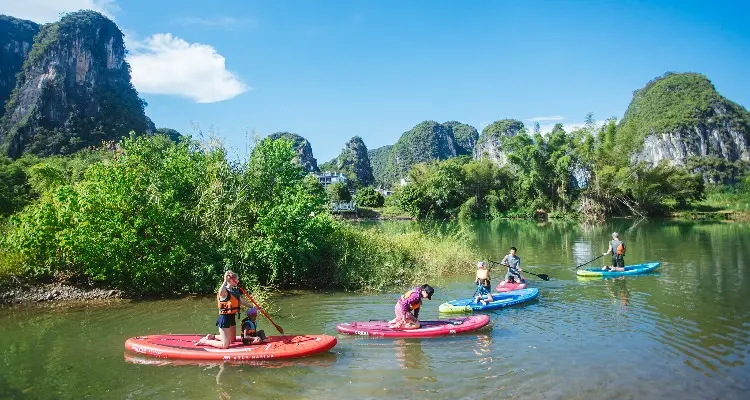 Outdoor activities in Guilin
Outdoor activities in GuilinBesides the basic Beijing, Xi’an, and Shanghai elements, Guilin is recommended for outdoor lovers.
Guilin is suggested for its rich summer activity selection and relaxing vibe. Guilin offers many interesting outdoor activities like biking, caving, and many water activities.
You may need to set aside 11–14 days for this trip. When it comes to scheduling, especially when traveling with children, we recommend a flexible schedule.
To avoid the heat, block out the afternoon or schedule activities after 4 pm, like a sunset or night visit to the Great Wall.
Here is the sample itinerary:
- Days 1–3: Beijing sightseeing with all the must-see attractions and a special sunset visit to the Great Wall with a family picnic time.
- Days 4–5: Xi’an sightseeing with the Terracotta Army, a foodie tour, and a night walking tour.
- Days 6–9: Guilin with a Li River cruise and some interesting activities like caving, trying Chinese landscape painting, and SUP on a scenic river.
- Days 10–12: Shanghai with a visit to the Bund, a home visit and cooking experience, and some free time.

2. If You Are Looking for a Panda Tour
 Break bamboos for pandas
Break bamboos for pandasChengdu should definitely be included in addition to Beijing, Xi’an, and Shanghai if you are panda lovers. We also recommend a Yangtze River cruise from nearby Chongqing — a good way to avoid summer heat while enjoying China’s natural views.
Here is the suggested itinerary, which takes about 2 weeks:
- Days 1–4: Beijing arrival and exploration with must-sees including the Great Wall and the Forbidden City
- Days 5–6: Xi’an sightseeing with a visit to the Terracotta Army and clay-warrior-making experience
- Days 7–8: Chengdu panda tour with a keeper program — make panda cakes, see pandas being fed at a close distance, and clean the glass of their enclosures.
- Days 9–11: Yangtze River cruise with excursions
- Days 12–13: Shanghai exploration with a visit to the Bund and some free time.
3. If You Want to Avoid Heat
If you want to enjoy nice and cool weather conditions on your summer trip, Yunnan is definitely the best choice to combine with Beijing, Xi’an, and Shanghai.
For a Yunnan trip, Kunming, Dali, Lijiang, and Shangri-La are the four popular destinations.
Here is the itinerary:
- Days 1–4: Beijing arrival and exploration with must-sees including the Great Wall and the Forbidden City
- Days 5–6: Xi’an sightseeing with a visit to the Terracotta Army and clay-warrior-making experience
- Days 7–8: Kunming with a less-crowded Naigu Stone Forest exploration
- Days 9–10: Dali. Visit a local village to discover the daily life of the Bai people, dye a handkerchief, and taste the home-cooked local cuisine.
- Day 11: Lijiang. Visit Jade Dragon Snow Mountain and a Naxi family to learn about the mysterious Naxi culture.
- Day 12–14: Shangri-La. Visit a local Tibetan family, experience a Tibetan ceremony of blessing, learn to paint a thangka (‘sacred tapestry’), enjoy a starry night with a bonfire on the grassland…
- Days 15–16: Shanghai exploration with a visit to the Bund and some free time.
See more on How Long to Spend in China: Itineraries from 1 Week to 1 Month
Tibet is also a good destination for cool weather, as well as plateau scenery and mysterious Tibetan culture. If you are interested in Tibet, see our 2-Week Beautiful China with the Holy Tibet Tour.
Costs for a Summer Trip to China
Summer is the peak travel season for most of China. The price of hotels and airfares can go up by 50 to 100%. Other prices are relatively stable.
For a private tour, the average cost per day is about US$220–350 per person, including flights/trains within China, 4- or 5-star hotels, lunches, attractions, guides, and private transport. Kids under 10 get 30 to 50 percent off.
Hotels and flights to popular destinations will be in great demand during the summer vacation. If you are planning a trip to China during this period, we suggest booking 6 months in advance.
Crowding on a Summer Trip to China
China’s schools’ summer holidays usually encompass the months of July and August. So, crowds are expected, especially in popular destinations.
If you have a flexible schedule, a smarter choice is to travel in June, when there are fewer tourists and China’s summer vacations haven’t started.
We’ll also help you avoid crowds as much as possible, arranging VIP passage to avoid queuing, choosing less-crowded times of the day, etc. Our guide would also arrange a less crowded travel route for you, e.g. taking you on a hidden route when visiting the Forbidden City.
We also have tours to many off-the-beaten-track destinations, like the Silk Road, northern Sichuan, and Inner Mongolia. If you are interested in these destinations or you have other interests, just contact us. Our tours are personalized.
Recommended Summer Tours to China
Our private tours are designed to be the most convenient and fulfilling option for your trip to China. We would create an itinerary according to your flight times, interests, and any other requirements.
- 12-Day Beijing, Xi’an, Guilin, Shanghai Tour for Your Summer Vacation
- 2-Week Beijing – Xi’an – Chengdu – Yangtze Cruise – Shanghai Tour
- 11-Day Beijing–Xi’an–Guilin–Shanghai Classic Wonders Tour

Winter Trip
How's the weather?
Winter (December to February) is mostly a cost-effective and less-crowded time to explore China. China has multiple winter attractions/activities:
- Fun and well-equipped ski resorts
- Beautiful wintry scenic areas
- Huge winter festivals such as Harbin Ice and Snow Festival and the Spring Festival (Chinese New Year), adding excitement to the cool-to-freezing winter.
In this guide, we’ll provide you with tips on how to plan the best winter trip to China for you.
Choose Where to Go
The Top 6 China Winter Destinations
Below is a list of China’s prime winter destinations, from snow-covered landscapes to splendid winter festivals and activities.
1. Beijing — the Great Wall, Skiing, Chinese New Year Celebrations
 The Great Wall of China covered in snow
The Great Wall of China covered in snowIn Beijing’s winter, you can enjoy climbing the Great Wall and viewing its mountainous winter landscape in peace without the crowds.
It is also a good time to see how Chinese people celebrate Chinese New Year. You can experience the festival atmosphere, enjoy interesting outdoor activities, and taste the best local food. See a 6-Day Beijing Chinese New Year Tour.
If you want to ski, we can take you to an Olympic Winter Games venue to enjoy the fun and world-class facilities. Read more on 6-Day Beijing Winter Tour with Skiing in a Winter Olympics Venue.
2. Harbin — Ice and Snow Festival, Skiing
If you want to see stunning snow scenery and have a fun/romantic Christmas or New Year with your children or your significant other, then don’t miss the Ice and Snow Festival in Harbin.
The Ice and Snow Festival is undoubtedly Harbin’s most famous attraction in winter. The festival will last for around 2 months from late December to February. During the festival, Harbin is changed into a world of ice sculptures.
Yabuli Ski Resort, not far from Harbin, is one of the best in China. If you especially like snow scenery, then you could go on an extended tour to Changbai Mountain, where you can see the beautiful rime and try rafting on a hot spring river.
3. Huangshan — Snowy Mountains, Hot Spring
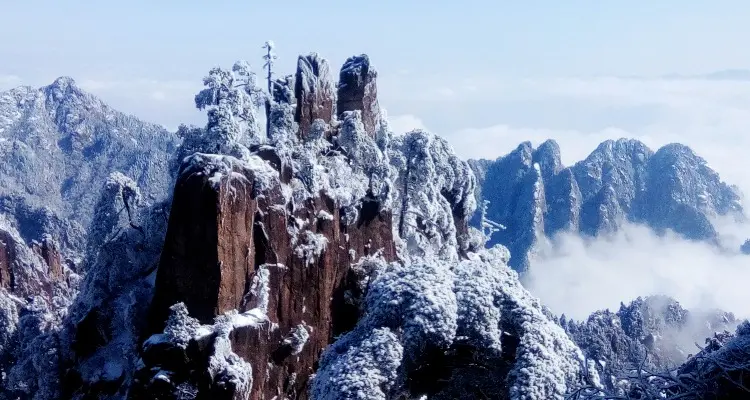 Snow scenery in Huangshan
Snow scenery in HuangshanThe Yellow Mountains (Huangshan) is one of the most famous mountain areas in China. Its snow-capped mountains and rime-covered trees are the perfect winter scene. If you love nature and photography, then Huangshan is a great destination for a winter trip.
A cozy hot spring experience could be a treat in winter, especially after climbing the mountain. There is a wonderful hot spring at the foot of the Yellow Mountains where you can get relaxed and refreshed.
4. Chengdu — Pandas, Hot Pot, Skiing
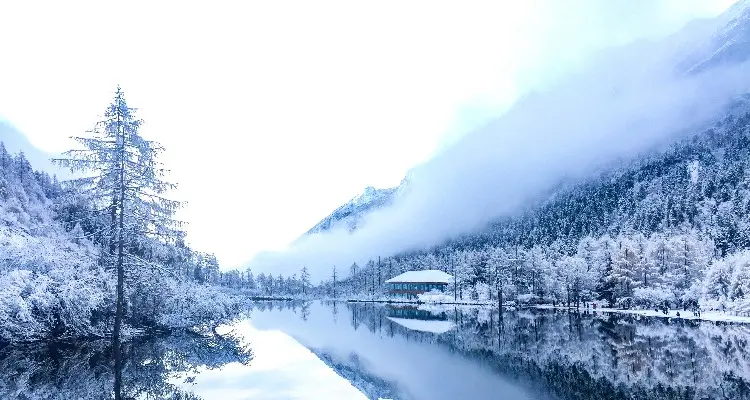 Bipenggou in winter
Bipenggou in winterYou shouldn’t miss Chengdu if you love pandas. In winter, you can still see active pandas playing in their playground as they’re not at all “afraid” of cold.
If you want to get closer to them and their habitat, we recommend our one-day panda volunteer program where you can clean the glass of their enclosures, watch them being fed, and make their food.
If you are a foodie, having a hot pot on a cold winter day is definitely a great experience.
Bipenggou National Park, a hidden winter resort near Chengdu, is recommended if you want to see snowy scenery, enjoy skiing, and soak in hot springs.
5. Xi’an — The Terracotta Warriors
 The Terracotta Warriors
The Terracotta WarriorsNo matter what the season, Xi’an is a must for first-time visitors to China. It is the ancient capital of China, where the first emperor of China established his capital. The famous Terracotta Warriors are his mausoleum.
You can also visit a cave-dwelling, a type of local residential house, to see how Xi’an cave-dwellers manage to stay warm in winter and cool in summer.
If you are lucky enough to get a snowy day, you will see a stunning Xi’an in snow, especially from the Old City Wall, which will take you back a thousand years to medieval China.
For More Ideas
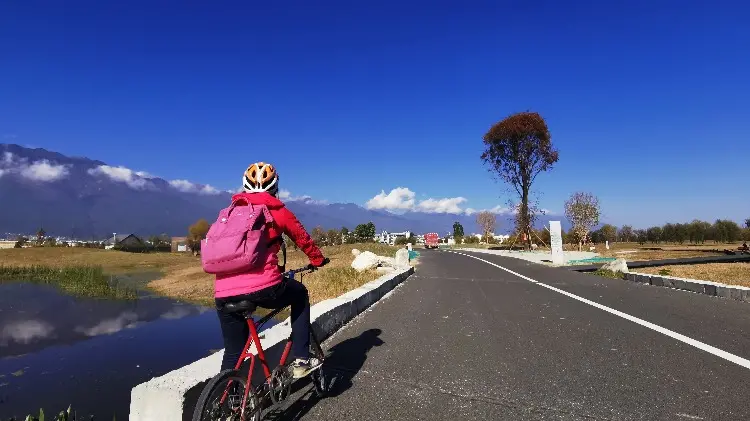 Biking along the Erhai Lake in winter in Dali, Yunnan
Biking along the Erhai Lake in winter in Dali, YunnanChina is a vast country. Besides the destinations listed above, there are still many places to go. If you like mild weather or want a beach holiday, Yunnan or Sanya could be your choice.
If you want a more unique snow and festival experience, then you can visit northern Xinjiang and Inner Mongolia.
Our service is personalized. You can tell us your interests and requirements and we will make a tour plan for you. You can also refer to our suggested itineraries below. All our tours can be adjusted based on your needs. Just contact us.
What’s the Weather Like in Winter in China
December to February is winter in China. Generally, January is the coldest month. If you want to enjoy snow scenery and snow activities, traveling in January and February is usually best.
If you want not-so-cold weather, then come in December. There are also fewer visitors in early December.
Winter in most parts of China is cold, but mostly sunny and drier. There are some differences between the North and the South.
North China is mostly close to 0°C (32°F) or below with snow. As a result, most of China’s excellent natural ski resorts are in the north, like Beijing and Harbin.
The temperature in most parts of southern China is around 5–10°C (41-50°F) with a much lower chance of snow. Further south, Guilin and Guangdong often see mild weather around 15°C (59°F).
Southernmost Hainan Island is a good place to enjoy sunshine and beaches in winter. It is very warm and the temperature stays around 20°C (68°F) in winter. Yunnan, in southwest China, also has a warm winter climate in its tropical south, but it’s mild to cold depending on the altitude further north.
Suggested Summer Itineraries
No matter what season you come to China, Beijing, Xi’an, and Shanghai are must-visit trios for first-timers. In addition to these cities, we also recommend some special winter cities for you in the itineraries below.
1. The (Winter) Itinerary for First-Timers
This is a classic China itinerary that you may want to refer to if it is your first time visiting China.
This 10‒11-day itinerary visits Beijing, Xi’an, Guilin, and Shanghai. You would not only see top China attractions like the Forbidden City, the Great Wall, the Terracotta Warriors, and the Bund but also visit Guilin, where you would see in southern China’s relatively mild winter and could see and experience idyllic rural scenery and lifestyles.
If you happen to be visiting during Chinese New Year, we could also arrange celebration experiences for you, like going to a New Year Fair and watching folk art performances.
Here is the suggested itinerary:
- Days 1‒3: Beijing (the Great Wall with a night tour, the Forbidden City…)
- Days 4‒5: Xi’an (the Terracotta Warriors, a food tour…)
- Days 6‒8: Guilin (a river cruise, countryside life experience, ethnic minority culture)
- Days 9‒11: Shanghai (the Bund, free time to explore)
If you want to ski, you could stay in Beijing for one or two more days, and we would arrange a great ski resort for you. Just contact us.

2. If You Prefer Snow Festivals and Activities
This itinerary is very suitable for those who are fond of snow scenery and want to attend a splendid snow festival.
Simply add Harbin into the itinerary with Beijing, Xi’an, and Shanghai. Harbin’s Ice and Snow Festival is definitely the grandest winter festival for travelers anywhere — a great place to celebrate Christmas and New Year.
You could also have a close encounter with many endangered Siberian tigers and enjoy a fun skiing vacation.
It would take about 13‒14 days. Here is the itinerary:
- Days 1‒3: Beijing (the Great Wall with a night tour, the Forbidden City…)
- Days 4‒8: Harbin (Ice and Snow Festival, Siberian tigers, ski…)
- Days 9‒11: Xi’an (the Terracotta Warrior, food tour…)
- Days 12‒14: Shanghai (the Bund, free time for exploration)
All our tours are customized. Our travel consultants would create your trip based on your needs, interests, group size, and travel time. Just contact us.
3. A Winter China Tour with Pandas
If you want to see pandas, then this itinerary is suitable for you.
Besides Beijing, Shanghai, and Xi’an, Chengdu is added, the hometown of pandas. You can take part in a volunteer program to take care of pandas, clean their bedrooms, make their food, and watch them be fed.
In Chengdu, you can also experience Chinese food culture in a group of people sitting around a hot pot — a lively and warm activity.
If you want to ski or enjoy hot springs, Bipenggou, near Chengdu, is a great choice with natural ski resorts and spectacular snow scenes.
- Days 1‒5: Beijing sightseeing with tai chi classes and a hutong family visit
- Days 6‒7: Xi’an sightseeing with hands-on experiences like making clay warriors and making dumplings
- Days 8‒10: Chengdu with a panda volunteer program and a food tour (if you want to ski at Bipenggou, you would need two more days. Just contact us.)
- Days 11‒13: Shanghai sightseeing with a Disneyland day

4. If You’re Looking for a Unique Winter Experience
Here are some itinerary ideas for if you’re seeking off-the-beaten-path destinations, unique winter scenery, and experiences, or a warm winter holiday:
- 6-Day Hulunbuir Winter Tour with Reindeer Experience
- 8-Day North Xinjiang Tour with Kanas
- 7-Day Kunming, Dali, and Lijiang Winter Tour
- 5-Day Sanya Tour with the Best Beach
Costs for a Winter Trip to China
Winter is a relatively cost-effective time to travel, except for holiday times like around Christmas and New Year, and Chinese New Year. During these holidays, the prices of air tickets and hotels will increase greatly.
For a private tour, the average cost per day is about US$220–350 per person, including flights/trains within China, 4- or 5-star hotels, lunches, attractions, guides, and private transport. Kids under 10 get 30 to 50 percent off.
If you are planning a trip to China, please book it at least 3 to 6 months in advance. We offer a free cancellation policy: you’ll receive a 100% refund of any payments made to China Highlights if you cancel up to three weeks before departure. (See more details.)
Crowding on a Winter Trip to China
Winter is the off-season for tourism when crowding is generally not an issue in China. However, there are a few holidays in winter in China, when there are crowds of Chinese tourists at attractions.
Christmas is not an official holiday in China, so there are not many tourists in December. There will be crowds during the New Year’s Day holiday on January 1–3.
Chinese New Year falls in late January or early-to-mid-February. Train stations and airports see huge increases in traffic for weeks before and after. But there are usually not many tourists at scenic spots, because most Chinese people get together at home during this holiday.
Tour China with Us
Our private tours are designed to be the most convenient and fulfilling option for your trip to China. We would create an itinerary according to your flight times, interests, and any other requirements. Just contact us.
- 8-Day Beijing – Xi’an – Shanghai Highlights Tour
- 11-Day Beijing – Xi’an – Guilin/Yangshuo – Shanghai Tour
- 2-Week Beijing – Xi’an – Chengdu – Yangtze Cruise – Shanghai Tour
- 2-Week Beijing – Xi’an – Zhangjiajie – Guilin/Yangshuo – Shanghai Tour

Family Trip
First-Time
China is a great family-friendly destination characterized by rich history, exotic culture, beautiful landscapes, and fascinating culinary adventures. Read on for family trip planning tips covering recommended cities, popular itineraries, travel costs, hotel choices, and more.
How Long
t is recommended to spend 12-14 days on a family trip to China.
This would allow you to cover the most popular cultural and natural highlights in China while giving you a chance to enjoy various experiences and activities with your children. This would also ensure a comfortable travel pace, and you shouldn’t get travel weary.
If your time permits and you want to take advantage of the opportunity to explore more of China’s landscapes and cultures, for example discovering some off-the-beaten-path routes with your children, it is advisable to spend three weeks or longer.
However, if your vacation time is limited, 7 to 9 days are needed to cover China’s top highlights in Beijing, Xi’an, and Shanghai.
Where to go?
Beijing, Xi’an, and Shanghai are the must-visit cities for first-timers. They provide a great introduction to China’s history, culture, and modernity.
Besides these three cities, there are more recommendations for families:
- Guilin is the best choice if you are looking for a fun and relaxing holiday with various outdoor activities and beautiful countryside views.
- If you and your kids are adventure lovers and love nature, Zhangjiajie is recommended.
- Chengdu is best for families who want to have an encounter with lovely pandas.
- If you want to enjoy a more leisurely pace or if you are planning a multi-generational family trip, you could consider including a Yangtze River cruise in your journey.
- If you want to explore bucket-list routes, Tibet and Yunnan would be good choices.
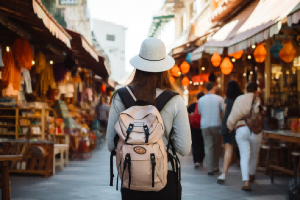
China Travel Guide
China's Guide
As one of the four exceptional ancient civilizations, China boasts a lengthy history and diverse geography—making it a coveted destination on many travelers’ bucket lists. With its wide-ranging cultural heritage and convenient travel amenities.From the iconic Great Wall to Shanghai’s soaring skyscrapers, all the way up to the “Roof of the World” and beyond, a trip to China guarantees an unforgettable, once-in-a-lifetime experience. Continue reading to ensure a seamless journey.
Top China Tours
**Beijing** As the capital of China, Beijing boasts numerous world-famous attractions. The Great Wall, a UNESCO World Heritage Site, attracts hordes of foreign visitors with its grand scale and historical symbolism. The Mutianyu section, in particular, is favored for its seamless integration of natural beauty and cultural heritage. The Forbidden City, a complex of imperial palaces from the Ming and Qing dynasties, allows visitors to intuitively grasp the essence of ancient Chinese imperial power and culture through its imposing architecture and extensive collection of cultural relics. Additionally, the garden art of the Summer Palace, hutong cultural experiences (such as Nanluoguxiang), and the urban landscape blending modernity and tradition (like the Guomao CBD) have won wide acclaim.
**Shanghai** An international metropolis, Shanghai presents a striking visual contrast between the European-style architectural complex on the Bund and the skyscrapers of Pudong’s Lujiazui, symbolizing the city’s “east-meets-west” charm. Cultural events like the Yuyuan Garden Lantern Festival also draw foreign visitors into interactive experiences. Shanghai offers an excellent shopping and consumption environment, high digital payment convenience, and a foreign card POS machine coverage rate exceeding 90%, significantly enhancing the tourist experience.
**Xi’an** As a historic and cultural city, Xi’an is home to the Terracotta Army Museum, hailed as the “Eighth Wonder of the World.” The vast formation and exquisite craftsmanship of the terracotta warriors shock visitors, serving as a window into China’s Qin Dynasty history. Historical sites such as the Xi’an City Wall and the Giant Wild Goose Pagoda further solidify its image as an “ancient capital,” attracting countless history and culture enthusiasts. As a city offering a 144-hour transit visa-free policy, Xi’an excels in inbound tourism services, such as providing multilingual guided tours. **Chengdu** Famous for its giant pandas and Sichuan-Chongqing culture, the Chengdu Research Base of Giant Panda Breeding is the only place in the world where visitors can observe giant pandas up close. The adorable charm of these pandas and their conservation stories serve as a “magnet” for international tourists, while the base’s bilingual services and payment facilitation (supporting 21 overseas e-wallets) have won widespread praise. Additionally, attractions like Kuanzhai Alleys and Mount Qingcheng, combined with Sichuan cuisine and Taoist culture, offer visitors a deep cultural immersion.
**Guilin** Renowned for the Li River’s landscapes and karst topography, the karst scenery along the Li River is praised as a “living Chinese landscape painting,” with traditional activities like cormorant fishing adding a layer of cultural immersion. The pastoral scenery and cycling experiences in Yangshuo have also become popular choices for foreign visitors to unwind. Thanks to its appearance in films and TV works (such as the spillover effect from Zhangjiajie, a filming location for *Avatar*) and celebrity recommendations, Guilin’s international reputation continues to rise.
Free consultation
These are our best sellers. Over 10,000 customers have helped select these as the most popular China Highlights tours. Of course each of them can be tailor-made to your requirements at the booking stage. Take a look and contact us. Our consultancy is free.
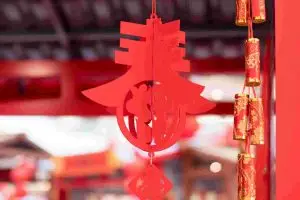
Chinese Culture
Festival
China is one of the Four Ancient Civilizations (alongside Babylon, India and Egypt), according to Chinese scholar Liang Qichao (1900). It boasts a vast and varied geographic expanse, 3,600 years of written history, as well as a rich and profound culture. Chinese culture is diverse and unique, yet harmoniously blended — an invaluable asset to the world.
Our China culture guide contains information divided into Traditions, Heritage, Arts, Festivals, Language, and Symbols. Topics include Chinese food, World Heritage sites, China’s Spring Festival, Kungfu, and Beijing opera.
Chinese New Year 2026
Chinese New Year, also known as Lunar New Year or Spring Festival, is the most important festival in China and a major event in some other East Asian countries.
Chinese New Year is the festival that celebrates the beginning of a new year on the traditional Chinese lunisolar calendar. Chinese New Year 2026 will fall on Tuesday, February 17th. The date changes every year but is always somewhere in the period from January 21st to February 20th.
It was traditionally a time to honor deities and ancestors, and it has also become a time to feast and visit family members.
Chinese Food Culture
Chinese food is famous all over the world, but you may be shocked by its surprising range and variety of ingredients if you’ve only eaten in Chinese restaurants abroad. Chinese food has countless delicious and fantastic dishes. And people from different areas have different cuisine types, which can be bland, sweet, salty, spicy, or sour.

China's Heritage
China's Heritage
China’s national heritage is both tangible and intangible, with natural wonders and historic sites, as well as ethnic songs and festivals included. As of 2018, 53 noteworthy Chinese sites were inscribed on UNESCO’s World Heritage List: 36 Cultural Heritage, 13 Natural Heritage, and 4 Cultural and Natural Heritage.
World Heritage Sites in China
As of 2015, 48 noteworthy Chinese sites were inscribed on UNESCO’s World Heritage List: 37 Cultural Heritage, 8 Natural Heritage, and 3 Cultural and Natural Heritage. China is second only to Italy for World Heritage sites. A catalogue of all of the UNESCO World Heritage Sites located in China is shown below, with links to specific web pages that provide in-depth information.
Chinese Ancient Currency
In ancient China, coins were the main forms of currency. These coins can be made of copper, iron, lead, gold and silver with different shapes, weight and marks. Different from equivalents like draught animals, textiles and shells, ancient coins play an important role in archaeology, that they not only have the reference value to judge the history of relics or remains, but also are significant materials for researching the history of commercial economy in ancient times. Because draught animals and cereals are difficult to deposit and divide, Chinese forebears used shells as a medium of exchange and unit of account in commerce during the last phase of the primitive society. The metal coins turned up in the last phase of the Spring and Autumn Period (770 BC–476 BC), and the history of paper currency in China can be dated up to the Northern Song Dynasty (960–1127).
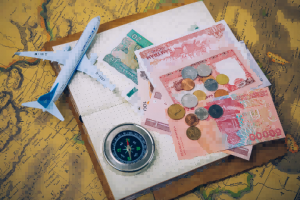
China Visa-Free Tours 2025/2026
Tourist visa
China offers 6 main visa-free policies, as outlined below. Under these policies, most travelers can enjoy visa-free travel to China for a specified duration.
- 240-Hour Visa-Free Transit: Individuals from 54 eligible countries, including Russia, Brazil, the United Kingdom, the United States of America, and Canada, traveling from China to a third country (region), can enter visa-free through any of the 60 open ports in 24 provinces (autonomous regions and municipalities), and stay within the allowed areas for visa-free transit travelers for no more than 240 hours.
- 30-Day Visa Free for Specific Countries: Citizens from countries like Brazil, Argentina, Chile, Peru, Uruguay, Australia, Austria, Belgium, Brunei, France, Germany, Hungary, Ireland, Italy, Luxembourg, Netherlands, New Zealand, Poland, Spain, Switzerland, Denmark, Portugal, Greece, Cyprus, Slovenia, Singapore, Malaysia, United Arab Emirates, Thailand, etc.
- 15-Day Visa-Free Policy for Cruise Ship Visitors: Travelers can partake in short excursions with an authorized travel agency for up to 15 days during a cruise along China’s coastline without needing a China visa.
- 6-Day Visa-Free for Tour Groups to Pearl River Delta: Visitors can explore cities like Guangzhou, Shenzhen, and Zhuhai from Hong Kong or Macau without a visa for 6 days or less, provided the tour is organized by a travel agency based in Hong Kong or Macau.
- Visa-Free Access for Hainan Island: Available to most nationalities visiting Hainan Province (Sanya, Haikou, etc.) for up to 30 days.
- Visa-Free for ASEAN Member States to Guilin: ASEAN member states can visit Guilin without a visa for a maximum of 6 days when traveling with an approved tour group.
If you are unsure about your eligibility for visa-free entry to China, feel free to contact one of our China tour experts. China Highlights can assist you in understanding these policies and preparing the required documents.
240-hour travel transit visa-free
Beijing is China’s must-visit city, known for its imperial history and architecture, no matter what the season, and especially for first timers.
Beijing’s summer is moderately wet and hot. But almost all the indoor attractions like the museums in the Forbidden City are air-conditioned. Heat won’t be a big problem for a summer visit.
The warm weather is good for a visit to the mountainous Great Wall. We suggest a sunset or night visit to avoid the heat of the day and the crowds. For a sunset visit, we can also arrange a picnic for you.
Xi’an
Xi’an is the best city for getting to know China’s traditional culture.
The main attraction in Xi’an is the Terracotta Warriors. It won’t be affected by the weather. For a special-interest activity, we can arrange the hands-on experience of making your own terracotta warrior in a cool and quiet workshop.
If you want to avoid the heat, a night tour of the city is recommended. We will arrange a fun and culturally-rich evening tour, where you can see the bustling nightlife in Xi’an, with food, street performances, and antique architecture, which would take you back to the medieval Xi’an of over a thousand years ago.
Shanghai:
As one of China’s top gateway cities, Shanghai is another place to visit no matter what season you come to China.
Shanghai is a place where century-old history meets modernity. The Bund is the best place to experience such a contrast.
We would like to enable you to enter historical buildings along the Bund and tell you the stories behind them. This would allow you to get to know Shanghai in a more in-depth way, and that without getting caught in the sun.
A cruise on the Huangpu River to see the skyscrapers to also a good way to learn about Shanghai. In summer, we recommend a night cruise for a cooler feeling and charming night views.
Guilin is best for seeing Chinese countryside views and experiencing the vitality of summer.
Yangshuo, a town near Guilin has plenty of cool outdoor activities for summer, especially for families with kids like discovering a cool and authentic karst cave and having fun on an SUP on a picturesque river.
If you are interested in local countryside life, take a local farmer’s taxi to a market in a small town.
Chengdu:
The biggest draw in Chengdu is the cute giant pandas. Pandas are “afraid” of heat. If you want to see pandas playing outdoors, try to go around 8 to 9 am. They will probably go indoors to rest in their air-conditioned rooms after 10 am.
We have access to giant panda volunteer programs that allow you to see pandas closer. You wouldn’t have to line up at the right time to watch them. You could make panda cakes, watch pandas being fed, and clean the glass of their enclosures.
Yunnan:
If you want to find a place to escape the heat, then Yunnan is a good choice. Yunnan’s summers are cool and beautiful.
Yunnan enjoys stunning scenery like the sparkling Erhai Lake, majestic Jade Dragon Mountain, and one of the deepest gorges in the world — Tiger Leaping Gorge. Yunnan is also a great place to learn about minority cultures.
Tibet:Summer is the best time to visit Tibet for its nicest weather and stunning scenery. The warm summer air has a higher oxygen content than in other seasons.
Journey to Everest Base Camp and witness the starry sky and the morning sunshine on the world’s highest peak. It must be on many people’s bucket lists, as well as seeing the Potala Palace and various temples and discovering the religious significance and stories behind them.
If you are interested in Tibetan festivals, visit Tibet in August when the Shoton Festival, Nagqu Horse Racing Festival, and Ganden Thangka Festival are held.
If you want to learn about Tibetan folk customs and their life, we can arrange a local Tibetan family visit. You could also participate in their daily farming.




